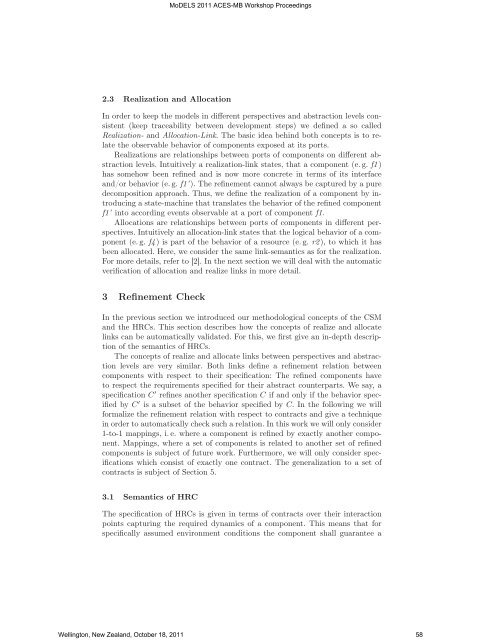A Refinement Checking Technique for Contract-Based Architecture ...
A Refinement Checking Technique for Contract-Based Architecture ...
A Refinement Checking Technique for Contract-Based Architecture ...
You also want an ePaper? Increase the reach of your titles
YUMPU automatically turns print PDFs into web optimized ePapers that Google loves.
2.3 Realization and Allocation<br />
In order to keep the models in different perspectives and abstraction levels consistent<br />
(keep traceability between development steps) we defined a so called<br />
Realization- and Allocation-Link. The basic idea behind both concepts is to relate<br />
the observable behavior of components exposed at its ports.<br />
Realizations are relationships between ports of components on different abstraction<br />
levels. Intuitively a realization-link states, that a component (e. g. f1 )<br />
has somehow been refined and is now more concrete in terms of its interface<br />
and/or behavior (e. g. f1’). The refinement cannot always be captured by a pure<br />
decomposition approach. Thus, we define the realization of a component by introducing<br />
a state-machine that translates the behavior of the refined component<br />
f1’ into according events observable at a port of component f1.<br />
Allocations are relationships between ports of components in different perspectives.<br />
Intuitively an allocation-link states that the logical behavior of a component<br />
(e. g. f4 ) is part of the behavior of a resource (e. g. r2 ), to which it has<br />
been allocated. Here, we consider the same link-semantics as <strong>for</strong> the realization.<br />
For more details, refer to [2]. In the next section we will deal with the automatic<br />
verification of allocation and realize links in more detail.<br />
3 <strong>Refinement</strong> Check<br />
In the previous section we introduced our methodological concepts of the CSM<br />
and the HRCs. This section describes how the concepts of realize and allocate<br />
links can be automatically validated. For this, we first give an in-depth description<br />
of the semantics of HRCs.<br />
The concepts of realize and allocate links between perspectives and abstraction<br />
levels are very similar. Both links define a refinement relation between<br />
components with respect to their specification: The refined components have<br />
to respect the requirements specified <strong>for</strong> their abstract counterparts. We say, a<br />
specification C ′ refines another specification C if and only if the behavior specified<br />
by C ′ is a subset of the behavior specified by C. In the following we will<br />
<strong>for</strong>malize the refinement relation with respect to contracts and give a technique<br />
in order to automatically check such a relation. In this work we will only consider<br />
1-to-1 mappings, i. e. where a component is refined by exactly another component.<br />
Mappings, where a set of components is related to another set of refined<br />
components is subject of future work. Furthermore, we will only consider specifications<br />
which consist of exactly one contract. The generalization to a set of<br />
contracts is subject of Section 5.<br />
3.1 Semantics of HRC<br />
MoDELS 2011 ACES-MB Workshop Proceedings<br />
The specification of HRCs is given in terms of contracts over their interaction<br />
points capturing the required dynamics of a component. This means that <strong>for</strong><br />
specifically assumed environment conditions the component shall guarantee a<br />
Wellington, New Zealand, October 18, 2011 58
















